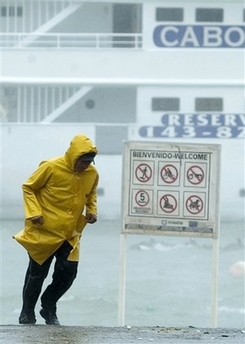Twin storms pack dangerous winds
Updated: 2007-09-05 09:35
CABO SAN LUCAS, Mexico -- Felix walloped Central America's remote Miskito coastline and Henriette slammed into resorts on the tip of Baja California as a record-setting hurricane season got even wilder Tuesday with twin storms making landfall on the same day.
 A man fights the wind during hurricane Henriette at Cabo San Lucas, Mexico, Tuesday Sept. 4, 2007. [AP] |
While weakening rapidly, Felix's rains posed a danger to inland villages lying in flood-prone mountain valleys and to urban shantytowns susceptible to mudslides.
Felix roared ashore before dawn as a Category 5 storm along Nicaragua's remote northeast corner - an isolated, swampy jungle where people get around mainly by canoe. The 160 mph winds peeled roofs off shelters and a police station, knocked down electric poles and stripped humble homes to a few walls.
"The metal roofs are coming off like straight razors and flying against the trees and homes," Lumberto Campbell, a local official in Puerto Cabezas, near Felix's landfall, told Radio Ya shortly before his phone line went dead.
Emergency official Samuel Perez said most of the port's buildings were damaged and the dock was destroyed, although there were no reports of deaths.
By late afternoon, Felix had weakened to a Category 1 storm with winds of 80 mph. But forecasters were still worried that the tempest would do great damage inland over Honduras and Guatemala. Up to 25 inches of rain was expected to drench the mountain capitals of Tegucigalpa and Guatemala City, where shantytowns cling precariously to hillsides.
Towns across Honduras were flooding, and residents waded through waist-deep, garbage-strewn water in La Ceiba, on the northern coast.
In 1998, Hurricane Mitch parked over the same region for days, causing deadly flooding and mudslides that killed nearly 11,000 people and left more than 8,000 missing.
"The major concern now shifts to the threat of torrential rains over the mountains of Central America," said senior hurricane specialist Richard Pasch at the National Hurricane Center in Miami.
The Honduran government was draining water from behind dams in an attempt to reduce the flooding danger, and 10,000 people were being evacuated from high-risk areas of the capital, mostly from poor neighborhoods and street markets that ring the city.
"If they don't do it voluntarily, we will force them," Tegucigalpa Mayor Ricardo Alvarez said. "We have 500 soldiers and 200 police for just that purpose."
|
|
|
||
|
||
|
|
|
|

